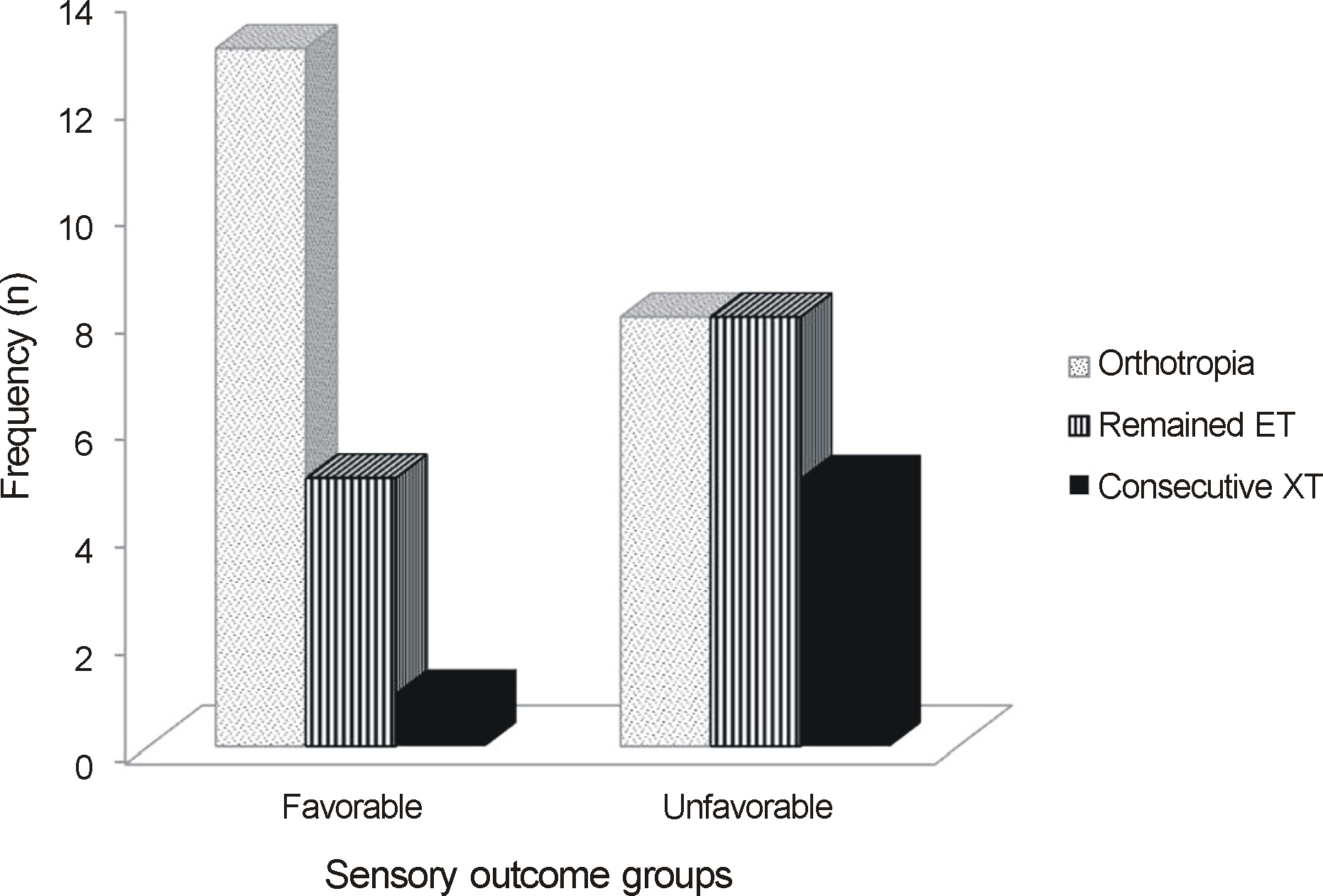J Korean Ophthalmol Soc.
2014 Feb;55(2):271-277. 10.3341/jkos.2014.55.2.271.
What to Predict Favorable Long-Term Sensory Outcome after Surgery for Infantile Esotropia?
- Affiliations
-
- 1Department of Ophthalmology, Gachon University Gil Hospital, Incheon, Korea. hjpaik@gilhospital.com
- KMID: 2218422
- DOI: http://doi.org/10.3341/jkos.2014.55.2.271
Abstract
- PURPOSE
To analyze pre- and post-operative factors associated with favorable long-term sensory outcome after surgical correction for infantile esotropia.
METHODS
This study retrospectively examined 40 patients with infantile esotropia who underwent surgery from January 2000 to December 2010. Clinical characteristics analyzed included age at onset, age at surgery, mean preoperative deviation, amblyopia on initial visit, other associated strabismus (Inferior oblique overaction (IOOA), dissociated vertical deviation (DVD), latent nystagmus), initial and subsequent postoperative motor alignment at 1-week and 2-year follow-up, recurrence rate, and stereopsis. Long-term sensory outcome was categorized as favorable (< or =400 arcsec) or unfavorable (>400 arcsec).
RESULTS
The mean follow-up period was 92.53 +/- 46.46 months. There were 19 patients (47.5%) in the favorable group and 21 (52.5%) in the unfavorable group. There were no statistically significant differences between the groups with respect to age at onset or surgery, presence of amblyopia, and prevalence of IOOA and DVD, latent nystagmus, or initial postoperative alignment at 1-week. There was a tendency towards worse binocularity with larger preoperative angles of esodeviation, but it was not significant. Binocularity was significantly higher among those who had surgery at age < or =24 months than at age >24 months. Orthotropic alignment within +/-10 PD at 2-year follow-up was 68.4% in the favorable group and 38.1% in the unfavorable group. Reoperation was performed on 8 patients (38.1%) in the unfavorable group and no patients (0.0%) in the favorable group.
CONCLUSIONS
Surgical correction of infantile esotropia within the first 2 years of life and maintenance of orthotropic alignment within +/-10 PD without additional surgery with a minimum follow-up of 2 years may be associated with favorable long-term sensory outcome in infantile esotropia.
Keyword
MeSH Terms
Figure
Reference
-
References
1. Shauly Y, Miller B, Meyer E.Clinical characteristics and long-term postoperative results of infantile esotropia and myopia. J Pediatr Ophthalmol Strabismus. 1997; 34:357–64.
Article2. Keskinbora KH, Gonen T, Horozoglu F.Outcome of surgery in long-standing infantile esotropia with cross fixation. J Pediatr Ophthalmol Strabismus. 2011; 48:77–83.
Article3. Pediatric Eye Disease Investigator Group. The clinical spectrum of early-onset esotropia: experience of the Congenital Esotropia Observational Study. Am J Ophthalmol. 2002; 133:102–8.4. Trigler L, Siatkowski RM.Factors associated with horizontal reop-eration in infantile esotropia. J AAPOS. 2002; 6:15–20.
Article5. Gerth C, Mirabella G, Li X. . Timing of surgery for infantile esotropia in humans: effects on cortical motion visual evoked responses. Invest Ophthalmol Vis Sci. 2008; 49:3432–7.
Article6. Ing MR.Early surgical alignment for congenital esotropia. Trans Am Ophthalmol Soc. 1981; 79:625–63.
Article7. Ing MR.The timing of surgical alignment for congenital (infantile) esotropia. J Pediatr Ophthalmol Strabismus. 1999; 36:61–8. quiz 85-6.
Article8. France TD, Ver Hoeve JN.VECP evidence for binocular function in infantile esotropia. J Pediatr Ophthalmol Strabismus. 1994; 31:225–31.
Article9. Birch EE, Stager DR Sr. Long-term motor and sensory outcomes after early surgery for infantile esotropia. J AAPOS. 2006; 10:409–13.
Article10. Birch EE, Fawcett S, Stager DR.Why does early surgical align-ment improve stereoacuity outcomes in infantile esotropia? J AAPOS. 2000; 4:10–4.
Article11. Simonsz HJ, Kolling GH.Best age for surgery for infantile esotropia. Eur J Paediatr Neurol. 2011; 15:205–8.
Article12. Birch EE, Stager DR, Everett ME.Random dot stereoacuity following surgical correction of infantile esotropia. J Pediatr Ophthalmol Strabismus. 1995; 32:231–5.
Article13. Bae SH, Choi DG.Clinical features and surgical outcomes of in-fantile esotropia according to the age at surgery. J Korean Ophthalmol Soc. 2008; 49:1961–7.
Article14. Helveston EM, Ellis FD, Schott J. . Surgical treatment of con-genital esotropia. Am J Ophthalmol. 1983; 96:218–28.
Article15. Lang J.The optimum time for surgical alignment in congenital esotropia. J Pediatr Ophthalmol Strabismus. 1984; 21:74–5.
Article16. Birch EE, Felius J, Stager DR Sr. . Pre-operative stability of in-fantile esotropia and post-operative outcome. Am J Ophthalmol. 2004; 138:1003–9.
Article17. Rowe FJ.Long-term postoperative stability in infantile esotropia. Strabismus. 2000; 8:3–13.
Article18. Hoyt CS, Jastrzebski GB, Marg E. Amblyopia and congenital esotropia. Visually evoked potential measurements. Arch Ophthalmol. 1984; 102:58–61.19. Weakley DR Jr, Holland DR.Effect of ongoing treatment of am-blyopia on surgical outcome in esotropia. J Pediatr Ophthalmol Strabismus. 1997; 34:275–8.
Article20. Simonsz HJ, Kolling GH, Unnebrink K.Final report of the early vs. late infantile strabismus surgery study (ELISSS), a controlled, prospective, multicenter study. Strabismus. 2005; 13:169–99.
Article21. Chung EJ, Chang YH, Chang JH. . Clinical manifestations and surgical outcome of infantile esotropia. J Korean Ophthalmol Soc. 2005; 46:853–8.22. Helveston EM, Neely DF, Stidham DB. . Results of early align-ment of congenital esotropia. Ophthalmology. 1999; 106:1716–26.23. Robb RM, Rodier DW.The variable clinical characteristics and course of early infantile esotropia. J Pediatr Ophthalmol Strabismus. 1987; 24:276–81.
Article24. Oh CH, Cho YA.Long-term alignment after bimedial rectus re-cessions for infantile esotropia. J Korean Ophthalmol Soc. 2002; 43:1706–12.25. Kim HK, Chung HJ, Park SH, Shin SY.Consecutive exotropia af-ter bilateral medial rectus recession for infantile esotropia. J Korean Ophthalmol Soc. 2009; 50:1712–6.
Article26. Louwagie CR, Diehl NN, Greenberg AE, Mohney BG.Long-term follow-up of congenital esotropia in a population-based cohort. J AAPOS. 2009; 13:8–12.
Article27. Lee KW, Lee SY, Lee YC.Sensory status in patients showing orthophoria after strabismus surgery in exotropes. J Korean Ophthalmol Soc. 2003; 44:128–33.28. Choi DK, Choi MY.Efficacy of spectacles before amblyopia treat-ment in anisometropic amblyopia. J Korean Ophthalmol Soc. 2011; 52:550–6.
Article
- Full Text Links
- Actions
-
Cited
- CITED
-
- Close
- Share
- Similar articles
-
- Long-Term Results of Three or Four Horizontal Muscles Surgery in Large Angle Infantile Esotropia
- The Long-Term Outcome of Lateral Rectus Advancement in Patients with Consecutive Esotropia Following Bilateral Lateral Rectus Recession for Intermittent Exotropia
- Early Surgery for Infantile Esotropia
- Long-Term Alignment after Bimedial Rectus Recessions for Infantile Esotropia
- Clinical Manifestations and Surgical Outcome of Infantile Esotropia




